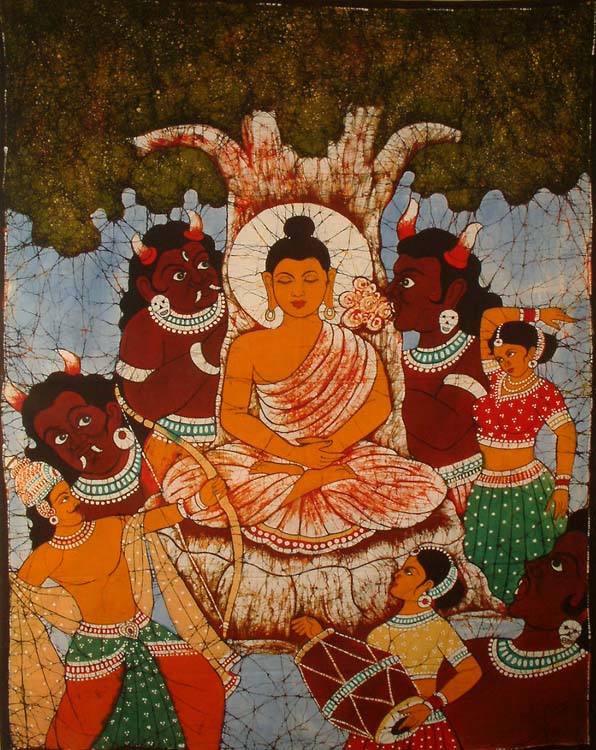In the Indiana Jones Adventure: Temple of the Forbidden Eye in Disneyland USA, the great explorer has discovered an ancient lost temple dedicated to the god Mara. Deep within the temple is the Chamber of Destiny, in which Mara reads the thoughts and ambitions of visitors. He then opens up one of three doors, leading to a chamber bestowing either earthly riches, eternal youth, or visions of the future. But beware the eyes of the idol: one look and you will be carried, screaming, into the Gates of Doom.
Of course, this is a Disney ride, so off to the Gates of Doom you go! Thankfully Dr. Jones is there holding them closed, which results in a wild ride through the rest of the temple and its various dangers. Is there any ethnographic basis for the deity Mara, though? Indeed there is, which adds another dimension to an excellent ride.
According to historical tradition, Siddhartha Gautama lived sometime between 600 and 400 BCE. A prince of the Shakya clan, whose lands were on the northeastern edge of India and part of modern Nepal, he led a very sheltered life unaware of ageing and suffering and death. At the age of 29, he was permitted to visit with the people of his clan, and then was the first time he encountered people who were old and sick. This puzzle of why there must be suffering haunted him, and he renounced his life of royalty to find his answer. Siddhartha studied with a number of yogis and great teachers of the Hindu religion, but found each of their paths wanting. He even went so far as to nearly kill himself with extreme asceticism, but decided that the best course of action was a Middle Way, living neither to complete self-indulgence nor total self-mortification. He then sat himself beneath a fig tree in Bodh Gaya, India, and pledged not to leave until he had found the answer to suffering. After 49 days of meditation, at the age of 35, his mind opened to the answer. He became the Buddha, the Awakened One.
What Buddha in his Enlightenment determined was what he called the Four Noble Truths. These truths are 1) life suffers, because 2) we cling to life and the cycle of death and rebirth by holding out expectations of how life should be, therefore 3) to overcome suffering and the cycle of death and rebirth we must overcome expectation, and we do that by 4) embracing the Noble Eightfold Path of right view or perspective, right intention or motivation, right speech, right action, right livelihood, right effort or discipline, right mindfulness or awareness, and right concentration or meditation. By understanding these truths and following this path, one may break out of Samsara - the continuous cycle of life and death and rebirth - into the state of potentiality called Nirvana, a "nothingness" in which one's attentions are no longer diverted by ignorance, attachment, and anger (that is, not understanding the nature of reality, desiring the things of this world, and frustration and fear over not getting the objects of one's desire).
Of course, the world of suffering is not going to give up without a fight, and that is where Mara comes in.
When Siddhartha sat beneath the tree at Bodh Gaya and was on the verge of attaining Enlightenment, the demon Mara came to him to seduce him into forsaking this path, returning to his life, and forgetting all about becoming Enlightened. In Buddhism, Mara represents all the passions and affections of the world that keep us from attaining Enlightenment and liberation from Samsara. One of the senses in which Mara's name is used is for the "death" that continues this cycle. Other meanings for Mara are as the embodiment of "unskillful emotions" (basically emotions untempered by the Noble Eightfold Path), a metaphor for the entirety of unenlightened or "conditioned" existence, and as an actual, objectively existing entity. Mara is temptation, distraction, the pleasures of the world crying out for our whole attention. In some versions of the story, after Mara himself fails his three sensual daughters attempt to seduce Siddhartha. They are Craving, Boredom, and Passion. In another version, there are five daughters, representing ignorance, attachment, and anger, as well as pride and fear.
 |
| Mara and his daughters attacking Buddha. Indian, artist unknown. |
Returning to The Temple of the Forbidden Eye, we come to realize something rather distressing. The ride's version of Mara offers earthly riches, eternal youth, or visions of the future... All of which would be considered attachments and distractions in Buddhism. Each of these involves clinging in one way or another to the cycle of Samsara, whether the pleasures of wealth and what it can buy or permanence of beauty and health or desire to anticipate and shape the future. As far as our spiritual state, path to Enlightenment, and liberation from the cycle of suffering go, Mara offers nothing but death. The Gates of Doom are just the more direct route.
Perhaps, then, what makes Mara so angry is that by looking him in the eye, we have defied his temptations?



No comments:
Post a Comment